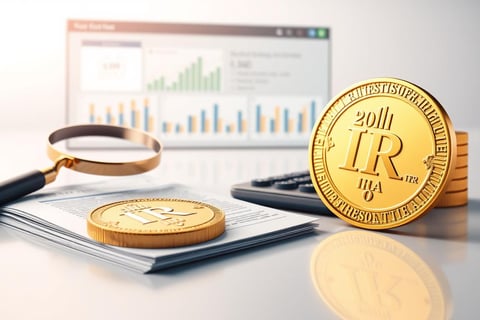How to Invest in a Gold IRA: Smart Steps for 2025 Retirement Planning
Learn how to invest in a gold IRA to help you protect your retirement savings from inflation and economic uncertainty.
HOW TO GUIDEGOLD IRA
Wellington Ashford
5/17/20259 min read


Did you know that 1 in 5 Americans over age 50 now hold precious metals in their retirement accounts? As markets grow more unpredictable, savvy planners are turning to physical assets like gold to protect their nest eggs. This guide will walk you through modern strategies to secure your future while navigating fees, storage rules, and tax perks.
A Gold IRA lets you own tangible assets within a tax-advantaged retirement account. Unlike stocks or bonds, gold often retains value during economic downturns, making it a strategic hedge. Whether you’re nearing retirement age or just starting, diversifying with this asset could stabilize your portfolio against inflation.
But there’s more to it than simply buying gold coins. You’ll need a specialized custodian to handle storage in IRS-approved facilities. Contribution limits and withdrawal timelines also differ from traditional IRAs. We’ll break down these details so you can decide if aligning part of your savings with gold aligns with your 2025 goals.
Key Takeaways
Gold IRAs offer tax-deferred growth while diversifying your retirement savings.
Physical gold acts as a safety net during market volatility.
Storage and custodial fees require careful comparison.
Annual contribution limits apply, similar to traditional retirement accounts.
Inflation protection is a key benefit for long-term planning.
Understanding Gold IRAs for 2025 Retirement Planning
Retirement planning today requires thinking beyond paper assets. A Gold IRA lets you hold physical assets like coins and bars in a tax-advantaged account. Unlike standard IRAs, which can’t store tangible metals, these specialized accounts offer unique stability during market swings.Write your text here...


What Makes This Retirement Tool Different?
The IRS strictly regulates approved metals. You can’t just stash collectible coins—only specific bullion types meet purity standards. For example, American Eagle coins qualify, while rare numismatic pieces don’t. A custodian handles storage in secure vaults, ensuring compliance.
Growing Your Savings Smarter
In 2025, individuals under 50 can contribute up to $7,000 annually ($8,000 if older). These limits mirror traditional IRAs but come with added perks. Pre-tax contributions grow tax-deferred, while Roth options allow tax-free withdrawals. Gold’s market price fluctuations mean your account value adjusts with global demand.
Investors often turn to precious metals when inflation looms. Physical gold historically holds value better than stocks during crises. By diversifying with tangible assets, you create a safety net that paper investments can’t match.
Essential Steps: How to Invest in Gold IRA
What does your ideal retirement look like? Whether you envision travel or quiet relaxation, aligning your goals with tangible assets starts with strategic planning. Let’s explore how to tailor your approach for maximum financial security.


Analyzing Your Investment Goals
Begin by sketching your retirement timeline and risk tolerance. Ask yourself:
How much income will you need monthly?
Does market volatility keep you awake at night?
Could physical gold balance your existing portfolio?
Metals like gold often shine when stocks stumble. However, they’re not for everyone. If preserving wealth long-term matters more than quick gains, this investment could fit your strategy.
Setting Up Your Gold IRA Account
Once committed, choose an IRS-approved custodian. These specialists handle storage logistics and paperwork. Here’s the process simplified:
Open a self-directed account (traditional or Roth)
Fund it through transfers or annual contributions
Select IRS-eligible bars or coins
Unlike standard retirement accounts, you’ll approve every metal purchase. Storage fees vary—compare custodians carefully. Most complete setup in 7-10 business days.
Remember: Diversifying with physical gold isn’t about getting rich quickly. It’s about creating stability so your golden years stay truly golden.
Diversify Your Retirement Portfolio with Precious Metals
Imagine your retirement savings as a sturdy ship navigating stormy markets—precious metals could be your anchor. Financial strategist Laura Collins puts it simply: "Gold’s role isn’t about chasing returns—it’s about preserving what you’ve built." With stocks and bonds vulnerable to sudden shifts, adding tangible assets creates balance you can physically trust.
Benefits of Including Physical Gold
Holding physical gold in your retirement account offers unique advantages:
Acts as a counterweight when paper assets dip
Requires secure storage in IRS-approved facilities
Maintains value during currency fluctuations
Unlike digital investments, you own something real. A 2024 Morgan Stanley report showed portfolios with 10-15% precious metals weathered recessions 32% better than those without.
Inflation Hedge and Diversification Strategies
Smart diversification means mixing asset classes. Consider these approaches:
Allocate 5-20% of your portfolio to metals like gold bars or silver coins
Rebalance annually to maintain your risk comfort zone
Monitor gold prices alongside stock indices for timing adjustments
When inflation hit 9% in 2022, gold gained 12% while the S&P 500 dropped 19%. This inverse relationship makes precious metals a strategic shield against economic surprises. Remember—your future security thrives on thoughtful variety, not putting all eggs in one basket.
Comparing Gold IRAs and Traditional IRAs
What’s your safety net when markets shake? While traditional IRAs lean on stocks and bonds, their gold-backed cousins offer a tangible alternative. Both aim to grow wealth, but their paths diverge sharply in fees, flexibility, and long-term potential.
Pros and Cons of Gold Investments
Gold IRAs shine brightest during economic storms. When the S&P 500 dropped 38% in 2008, gold prices climbed 5%. But this stability comes at a cost:
Tax advantages mirror traditional retirement accounts
Zero dividends or interest payments (unlike company stocks)
Annual storage fees averaging $150-$300
Traditional IRAs often charge lower maintenance fees—Vanguard’s average is 0.09% versus 1%-5% for gold custodians. You’ll also miss out on compounding growth from dividend-paying funds. However, metals don’t crash when a company mismanages earnings.
Here’s the trade-off: Gold lacks cash flow but resists inflation. Bonds provide steady income yet falter when rates rise. A 2023 Fidelity study found portfolios blending both strategies weathered market swings 27% better than single-asset approaches.
Your move? If preserving wealth matters more than explosive growth, mixing metals with traditional investments could soften volatility. Just remember—every choice balances risk against reward.
Exploring the Different Types of Gold IRA Accounts
Choosing the right retirement vehicle feels like picking a financial partner—each option shapes your future differently. Three main account types let you hold physical metals while catering to unique tax situations and career stages. Let’s decode what sets them apart.
Traditional, Roth, and SEP Options
Traditional accounts work best if you expect lower taxes later. Contributions reduce your current taxable income, with taxes due upon withdrawal. A teacher earning $65,000 annually might save $1,300 upfront by maxing their $6,500 limit.
Roth versions flip this script. Pay taxes now for tax-free growth—ideal if you’ll be in a higher bracket post-retirement. Freelancers under 50 can stash $7,000 yearly, while those over age 50 add $1,000 more.
Self-employed? SEP IRAs let business owners contribute up to 25% of income or $69,000 (2024 limit). A consultant making $150,000 could shield $37,500 from taxes while diversifying with metals.
Storage rules stay consistent across account types, but fees vary. Some custodians charge higher setup costs for SEPs. Always compare:
Annual maintenance fees
Metal purchase spreads
Insurance coverage details
Mixing account types can optimize tax outcomes. A married couple might split savings between Roth and Traditional to balance taxable income later. Your choice today ripples through decades—choose wisely.
Alternative Ways to Invest in Gold Beyond Physical Ownership
Not everyone wants to store gold bars under their mattress—and you don’t have to. Modern markets offer creative paths to benefit from gold’s stability without handling physical metals yourself. These options blend convenience with portfolio flexibility, letting you tap into gold’s potential through familiar financial tools.
Gold Funds and ETFs: Effortless Exposure
Exchange-traded funds (ETFs) like GLD track gold prices without storage hassles. You buy shares through your brokerage account—no vaults or insurance needed. Expense ratios average 0.40% annually, far below typical custodial fees for physical holdings.
Mutual funds take it further by pooling resources into mining companies and bullion. A 2023 Morningstar report showed gold-focused funds returned 14% during that year’s banking crisis. Just remember: these track markets, not ounces in your hand.
Stocks and Futures: Strategic Plays
Owning shares in mining firms links your returns to both gold prices and corporate performance. Newmont Corporation stock, for instance, rose 28% when bullion hit record highs last March. But management decisions and operational risks add layers of complexity.
Futures contracts let you bet on future prices through agreements to buy/sell later. While potentially lucrative, they require monitoring expiration dates and margin requirements. As trader Mark Douglas notes: "Futures magnify gains and losses—novices often underestimate the speed of both."
Diversification matters most. Combining physical gold with paper assets creates a balanced approach. Review each option’s liquidity—ETFs trade daily, while some mining stocks move slower. Your strategy should match both your risk appetite and the effort you’re willing to invest.
Managing Fees, Storage, and Tax Implications
Navigating the financial landscape of precious metals requires attention to three key areas: costs, security, and tax efficiency. Let’s explore practical strategies to keep more money working for you while meeting IRS requirements.
Breaking Down Custodian Costs
Gold IRAs typically charge higher fees than traditional accounts—$300 annually versus $20 for some stock-focused plans. These cover:
Secure storage in approved depositories
Insurance against theft or damage
Administrative paperwork and reporting
Some providers add setup fees up to $100. Always compare at least three custodians. Ask about price matching—many will negotiate to earn your business.
Smart Tax Moves for Metal Holdings
Traditional accounts let you defer taxes until withdrawal, while Roth versions offer tax-free growth. Miss a required distribution? You’ll face a 10% penalty plus owed taxes. Here’s how to stay ahead:
Track annual contribution limits ($7,000 for under 50s)
Rebalance holdings without triggering taxable events
Consult a tax pro before rolling over existing funds
Remember: Physical gold requires IRS-approved vaults. Home storage risks disqualifying your entire account. Review custodial agreements yearly—fee structures often change with market conditions.
Conclusion
Your retirement security deserves more than guesswork—it needs a strategy built on proven safeguards. Understanding physical gold IRAs means recognizing their unique role: tangible assets in tax-advantaged accounts, unlike traditional paper-based options. Diversifying with metals creates stability when markets dip, acting as your financial shock absorber.
Start by selecting an IRS-approved custodian and comparing fees for storage and maintenance. Remember, alternatives like ETFs or mining companies offer exposure without handling bars yourself. Annual contribution limits vary by age, so plan contributions around your timeline and income needs.
Successful strategies blend knowledge with action. Review custodial agreements thoroughly, rebalance holdings yearly, and consult a trusted advisor. Whether you choose physical gold or paper assets, consistent monitoring ensures your plan adapts to economic shifts.
Ready to fortify your future? Take these insights, weigh the pros and cons, and craft a retirement blueprint that weathers uncertainty. Your next step starts today—explore further or schedule a consultation to lock in your 2025 goals with confidence.
FAQ
What is a Gold IRA?
A Gold IRA is a self-directed retirement account that lets you hold physical metals like gold, silver, or platinum. Unlike traditional IRAs, it requires an IRS-approved custodian to manage storage and compliance. Approved assets include coins or bars meeting purity standards.
What tax benefits do Gold IRAs offer?
Depending on the type (Traditional, Roth, or SEP), you may get tax-deferred growth or tax-free withdrawals. Contributions to Traditional or SEP accounts can lower taxable income, while Roth withdrawals in retirement are tax-free if rules are followed.
How do I open a Gold IRA account?
Start by choosing a reputable custodian specializing in precious metals. They’ll help you fund the account (via rollover or contributions) and select IRS-approved metals. Your metals are stored in secure, insured facilities for safety.
Why add physical gold to my retirement portfolio?
Physical gold diversifies your assets, reducing reliance on stocks or bonds. It often holds value during market downturns and acts as a hedge against inflation, protecting purchasing power over time.
How does gold protect against inflation?
Gold’s value typically rises when the dollar weakens or inflation climbs. Unlike paper assets, its scarcity and global demand help maintain long-term purchasing power, making it a strategic buffer for retirement savings.
How do Gold IRAs differ from Traditional IRAs?
Gold IRAs hold tangible assets, while Traditional IRAs focus on stocks, bonds, or mutual funds. Precious metals offer diversification but come with storage fees and lower liquidity compared to paper investments.
Can I pick between Traditional, Roth, or SEP Gold IRAs?
Yes. Each type has unique tax rules. Traditional and SEP accounts use pre-tax dollars, while Roth uses after-tax funds. Your choice depends on income, tax goals, and retirement timeline.
Are there alternatives to physical gold in an IRA?
Absolutely. You can invest in gold ETFs, mining stocks, or mutual funds. These options offer exposure without storage costs, though they don’t provide direct ownership of physical metals.
What fees come with a Gold IRA?
Expect setup fees, annual custodial charges, and storage costs. These vary by provider—some offer flat rates, while others base fees on asset value. Always compare fee structures before committing.
How are withdrawals from a Gold IRA taxed?
Traditional and SEP accounts tax withdrawals as ordinary income. Roth withdrawals are tax-free if you’re over 59½ and meet the five-year rule. Early withdrawals may face penalties and taxes.
Invest
Secure
Trustworthy
© 2024 GoldIRARolloverGuide.net. All rights reserved.
